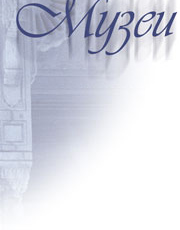
The Cathedral of the Annunciation
The Cathedral of the Annunciation was built by Russian master builders in 1485-89 on the reinforced socle of an earlier stone church of the early 15th century that had been taken apart. Unlike the Cathedral of the Dormition, and the Archangel Cathedral it was built "near the Grand Duke's porch" as part of the palatial complex and served as the domestic church of the grand dukes and tsars of Moscow.
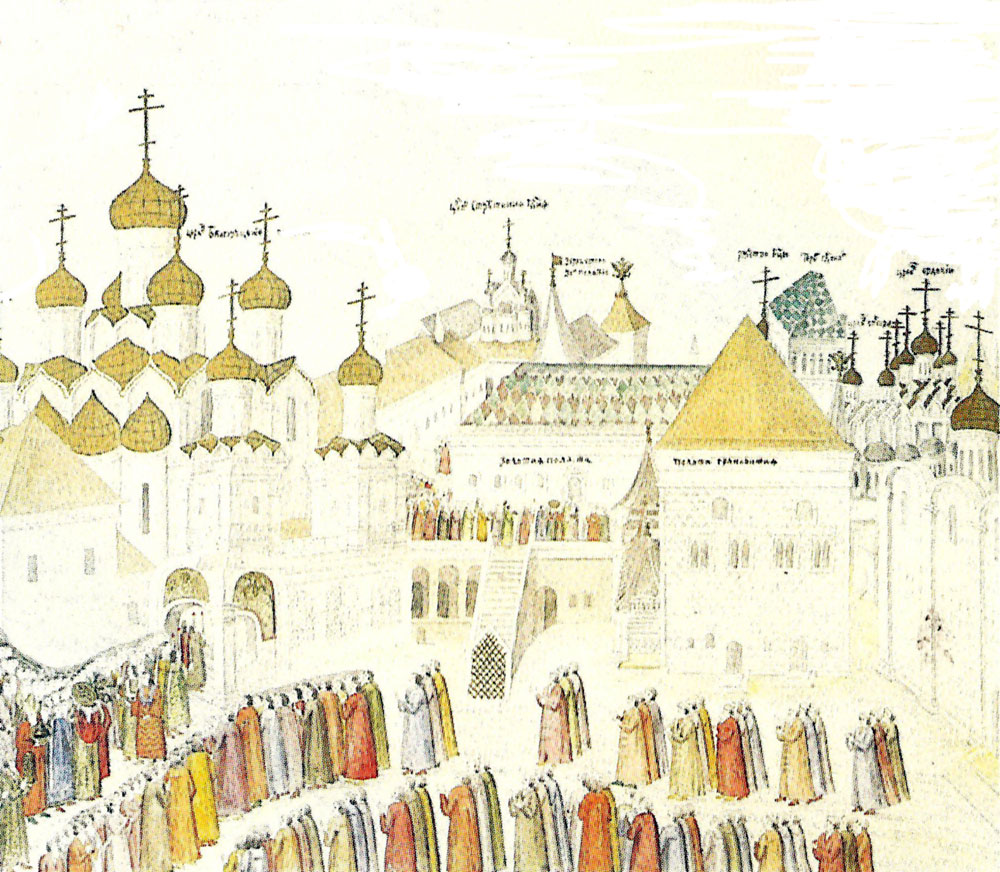
'Соборная площадь Московского Кремля (слева - Благовещенский собор)'. Миниатюра из 'Книги об избрании на царство царя и великого князя Михаила Федоровича'. XVII в. Cathedral Square of the Moscow Kremlin (on the left-Cathedral of the Annunciation). Miniature from the Book on the Election of tsar and Grand Duke Mikhail Fyodorovich to Tsardom. 17th century
Originally it was a well-proportioned building, square in horizontal section, made of brick and crowned with three domes. From the galleries skirting the building, staircases built on either side of the tall apses led down to the square. The Cathedral is a blend of different architectural traditions: the Pskov tradition; manifesting itself in the use of upraised stepped relieving arches in the design of the vaulting and in the original decor of the domes featuring ornamental bands of bricks placed on different sides (the so-called begunok and porebrik methods of brick-laying), and the Moscow tradition, which shows itself in making the plan of the cathedral in the form of a square and in using brick, which was a new building material at the time, instead of white stone. The tiers of pointed zakomary and kokoshniki, forming a gradual transition from the main part of the building to the drums of the domes and imparting a specially festive and picturesque appearance to the cathedral, are also characteristic features of Moscow architecture. The architecture of the Cathedral of the Annunciation is somewhat archaic as compared with the Cathedral of the Dormition and the Archangel Cathedral, built by Italian masters, whose design was evidently influenced by the traditions of Italian architecture.

'Апокалипсис' Роспись центральной части собора. XVI в Детали. The Apocalypse. Frescoes in the central part of the Cathedral. 16th century. Details
By the 1560s, in the reign of Ivan the Terrible, the appearance of the Cathedral of the Annunciation changed considerably. The galleries round the Cathedral were covered with vaults, and pier-less single-domed pridel churches were built at their four corners. One of them was dedicated to the feast of the Synaxis of the Theotokos, a second one to the archangel Michael (later on it was renamed in honour of the archangel Gabriel), a third one to the feast of the Entry into Jerusalem, and the fourth one to St George (subsequently this pridel was used as the vestry, and in 1822 it was rebuilt and dedicated to Prince Alexander Nevsky). At the time when the pridel churches were built, two blind domes were put up to the roof of the cathedral on its western side, and the domes and the roof were covered with gold-plated copper sheets.
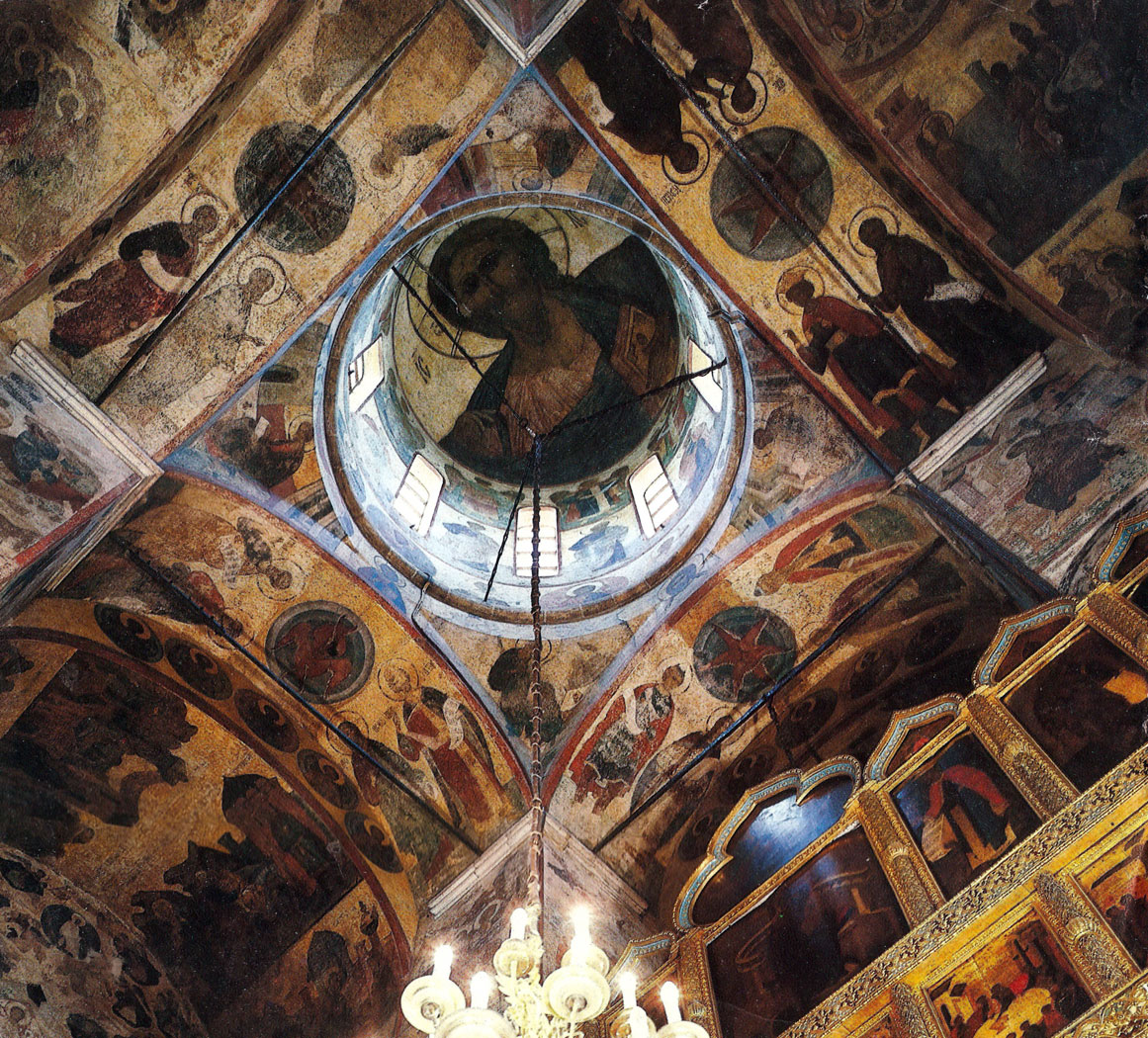
Благовещенский собор. Интерьер. Центральная часть. Cathedral of the Annunciation.Interior of the central part.
The Cathedral of the Annunciation was part of an intricate complex of palatial buildings consisting of separate palaces connected with one another by covered passageways, walks and galeries. adjoining it on its eastern side was the Treasury, the building in which the Grand Duke's treasures were kept; on its western side were the residential and grand reception apartments connected with the Cathedral by a covered stairway; and on the northern side stands the Palace of Facets, the main throne room of the palace. During Various ceremonies in the Cathedral Square, ceremonial processions went from the Cathedral of the Dormition to the Archangel Cathedral, then on to the Cathedral of the Annunciation and, finally, into the palace.
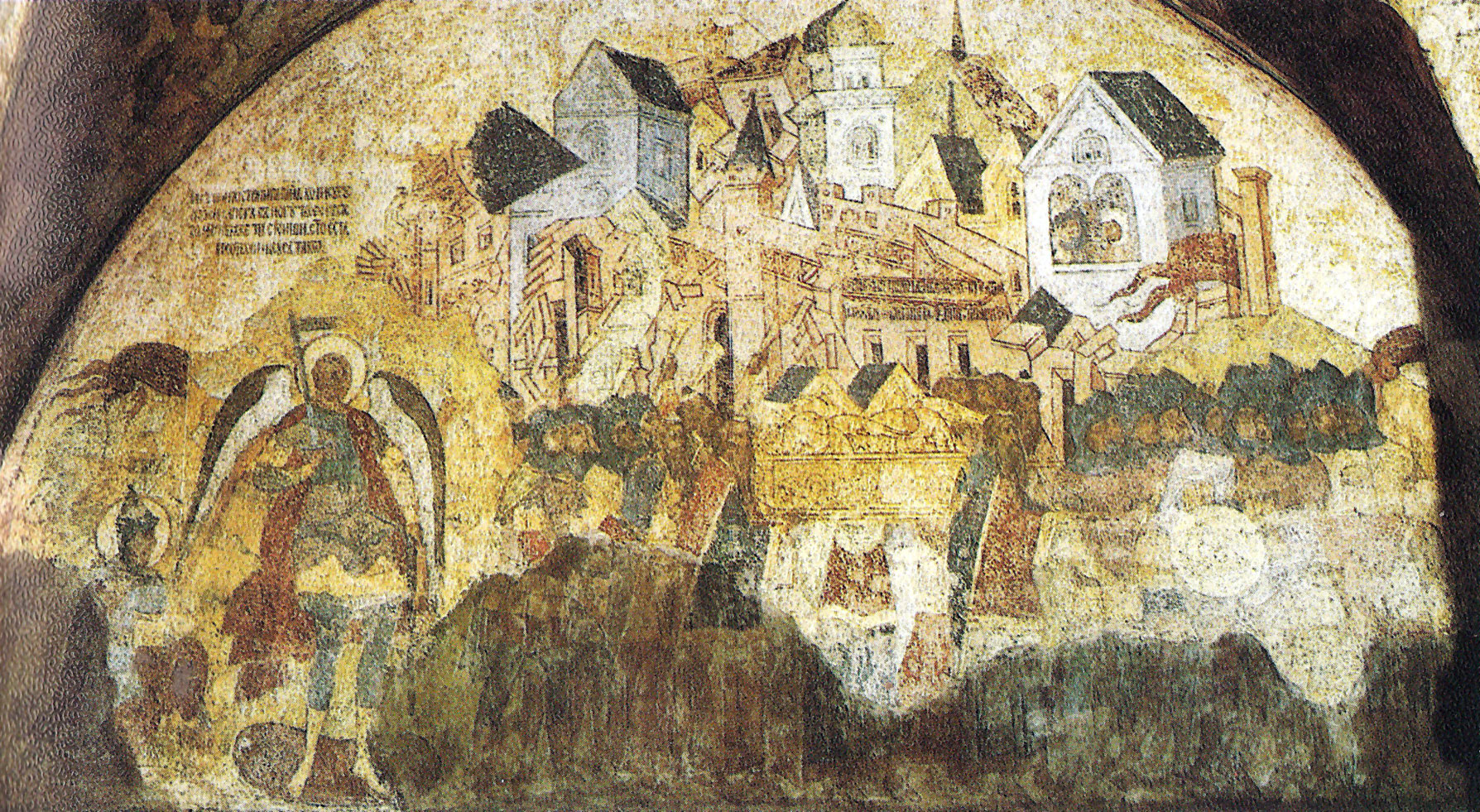
'Взятие Иерихона'. Роспись северного крыльца. XVI в. The Capture of Jericho. Fresco in the northern porch. 16th century
From olden times, the Cathedral of the Annunciation was a place where holy relics, especially venerated icons, old books, and sacred vessels were kept.
The interior of the Cathedral is rather small, much smaller than that of the Cathedral of the Dormition and the Archangel Cathedral. The contrast between the low vaults under the choir loft and the high space under the domes lends it particular expressiveness. Four square piers support the two-stepped arches of the vaults upon which the drum towers. It the north-western corner of the interior there is a white stone spiral staircase, concealed behind a semicircular projection of the wall, which leads to the choir loft. The provision of a choir loft and a minimum number of windows are a tribute to ancient architectural traditions.
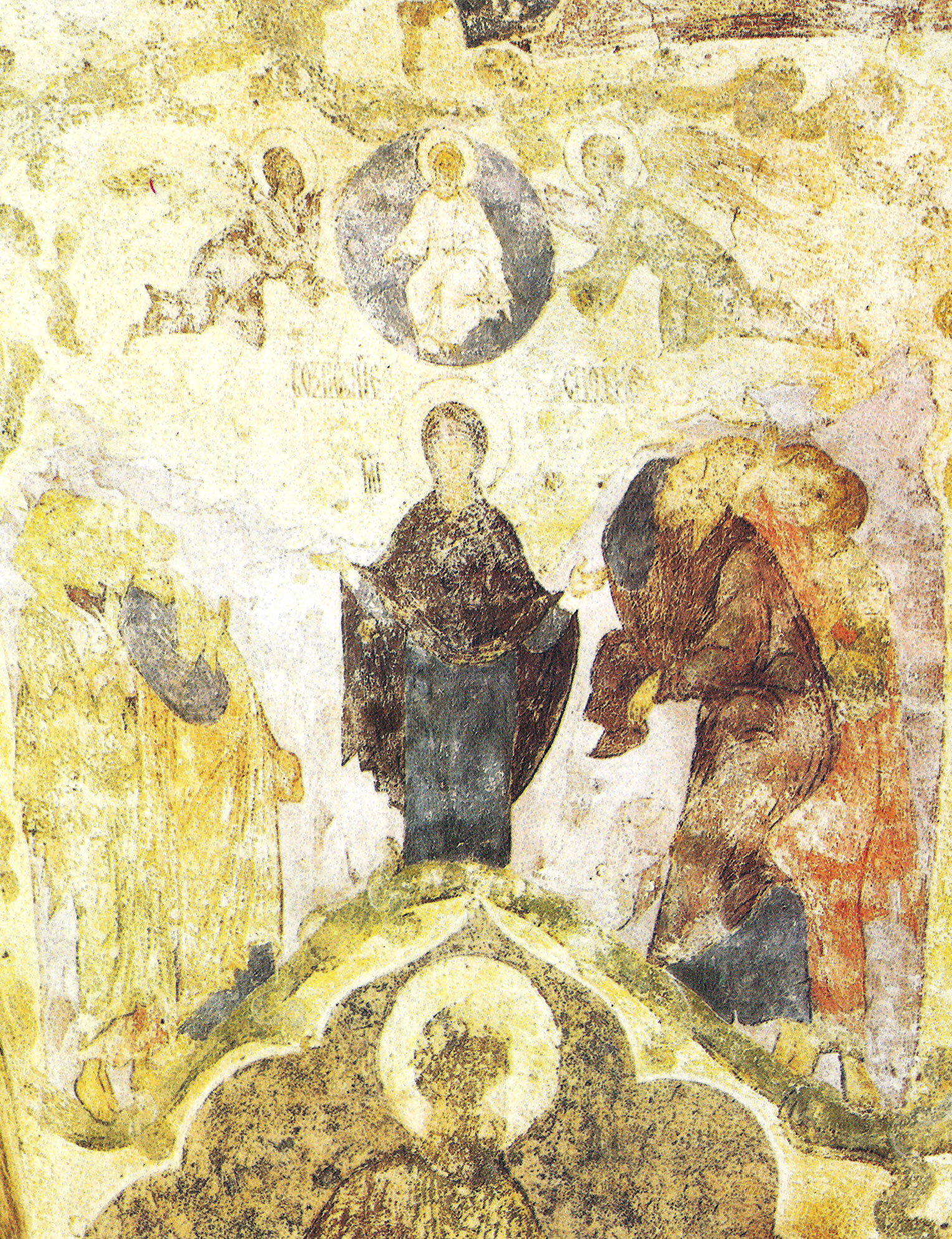
'Вергилий'. Роспись западной галереи. XVI в. Virgil. Fresco in the western gallery. 16th century
The palace which the Cathedral adjoined was often rebuilt. In the course of time, many of its parts and passageways were taken apart or altered, and in 1849 the architect Konstantin Thon erected the imposing building of the Grand Kremlin Palace on the site of older structures, dating from the 15th-18th centuries, some of which he incorporated in the new complex. It is this palace which provides the background against which the Cathedral of the Annunciation and the Palace of Facets are to be seen today. The tsars' domestic church was also redone: the vault of the central nave under the choir loft was raised and made horizontal instead of a low arched one; the parapet separating the choir loft from the central part was replaced with an openwork metal grille; and the narrow windows in the northern and southern walls were widened and made triple. As a result, not only the character of the interior was changed, but also the ensemble of frescoes was damaged.
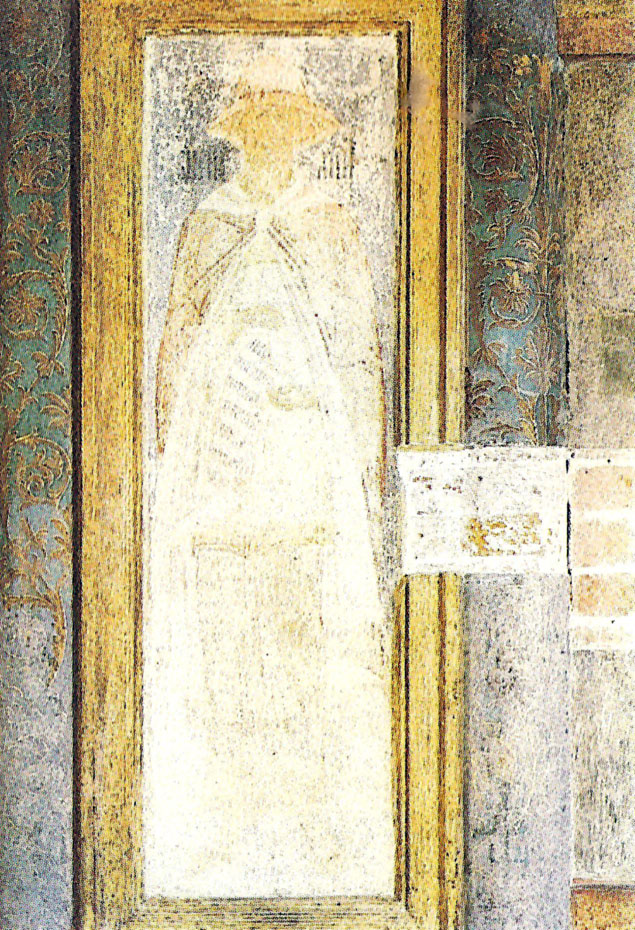
'Вознесение'. Роспись западной галереи. XVI в. Деталь. The Ascention. Fresco in the western gallery. 16th century. Detail
The first mention of the frescoes in the Cathedral of the Annunciation dates back to 1508. It is connected with the name of Theodosius, son of the famous ancient Russian painter Dionysius. Here is how the chronicler describes the beginning of the work: "... Grand Duke Vasily Ivanovich of All Russia ordered that the Church of the Annunciation of Our Lady the Mother of God in his courtyard be painted and that the painting be done by master Theodosius, son of Dionysius, and his team". During the nearly 500-year-long period of their existence, the frescoes were renovated more than once. It was after the terrible fire of 1547, which damaged almost every structure in the Kremlin, that they underwent the first serious alterations. It is even possible that at the time the frescoes were painted anew. They were also renovated several times in the 17th-19th centuries. The first attempt to remove the later overpaintings from them was made at the end of the 19th century. The subsequent stages of uncovering the ancient frescoes are associated with the work carried out by Soviet restorers in the 1940s, 1960s, and 1980-87. As a result of that work, the 16th-cen-tury frescoes once again saw the light of day.
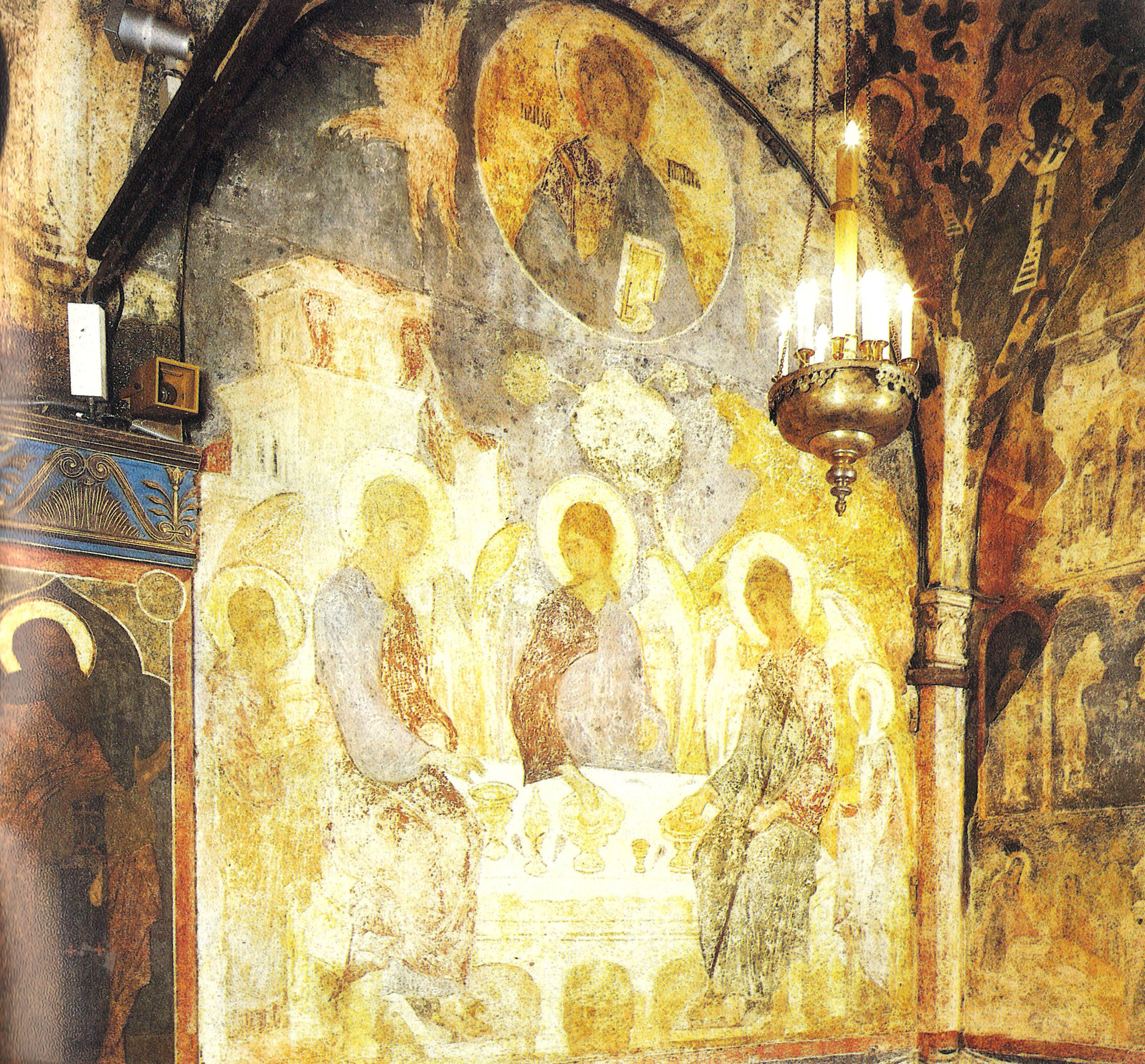
'Троица'. Роспись западной галереи. XVI в. The Trinity. Fresco in the western gallery. 16th century
The arrangement of the subjects and personages painted on the walls and vaults is determined by the canon, i.e. the rule expressively specifying the place to be occupied by each personage. Thus, the image of the Pantocrator is usually placed in the central dome, the images of prophets and patriarchs in the drum, the Evangelists on the pendentives, the figures of the archangel Gabriel and of Our Lady on the western sides of the eastern piers, scenes from the Gospel and parables on the vaults, and the Last Judgement on the western wall. Alongside traditional subjects, the theme of the Apocalypse, or the Revelation of St John the Divine, which is almost never to be seen in 16th- century monumental painting, found expression on the walls of the Cathedral. The Apocalypse is an early Christian writing, dating from the 1st century A.D., which depicts symbolically the destinies of the world and mankind, the struggle of good with evil and the eventual triumph of justice. Special emphasis in the Cathedral's murals is laid on subjects illustrating the various formidable prophecies. They occupy the upper parts of the arches and the walls under the choir loft. Then world of the mystic images represented here is extremely difficult to comprehend today. There is no doubt, however, that the contemporaries had a clear idea of their hidden meaning dictated, in the main, by the ideological and political situation prevailing at the time, when the struggle of the official church supported by the Tsar with the heretical movement that criticised the writtings of the holy fathers became particularly aggravated. The heretics were defeated, and the edifying and warning images painted on the walls of the domestic church consolidate the victory over them as it were. Such is, for example, the composition The Righteous Judge Is Coming and He Shalt Avenge, where Jesus is shown as the leader of the armies that are in heaven, hurling all kinds of evil-doers into the bottomless pit.
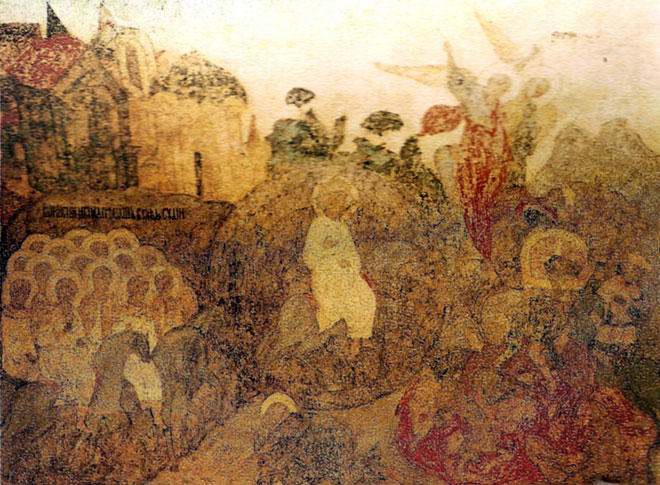
'Апокалипсис' Роспись центральной части собора. XVI в Детали.The Apocalypse. Frescoes in the central part of the Cathedral. 16th century. Details
The murals in the Cathedral of the Annunciation are arranged in horizontal rows with the compositions freely merging one into another, which is facilitated by the complex spatial positioning of the figures.
The architectural backgrounds and the personages are well proportioned to the surfaces allotted to them. The multi-figure dynamic scenes are painted in rich and pure colours.
The images painted on the piers reflect the theme of successiveness of the power of Moscow's ruling princes. Here you will see the Kiev Prince Vladimir and his grandmother Princess Olga, the famous military leader Prince Alexander Nevsky, the rulers of the Grand Duchy of Moscow Ivan Kalita and Dmitry Donskoi, the hero of the Battle of Kulikovo, and the Moscow Grand Dukes Ivan III and Vasily II. The paintings of the Byzantine emperors Constantine and his mother Helen, and also Michael III and Theodora illustrate, as it were, the political idea of Moscow rulers' inheritance of the power from Kiev princes and Byzantine emperors, which was of much significance at the time.
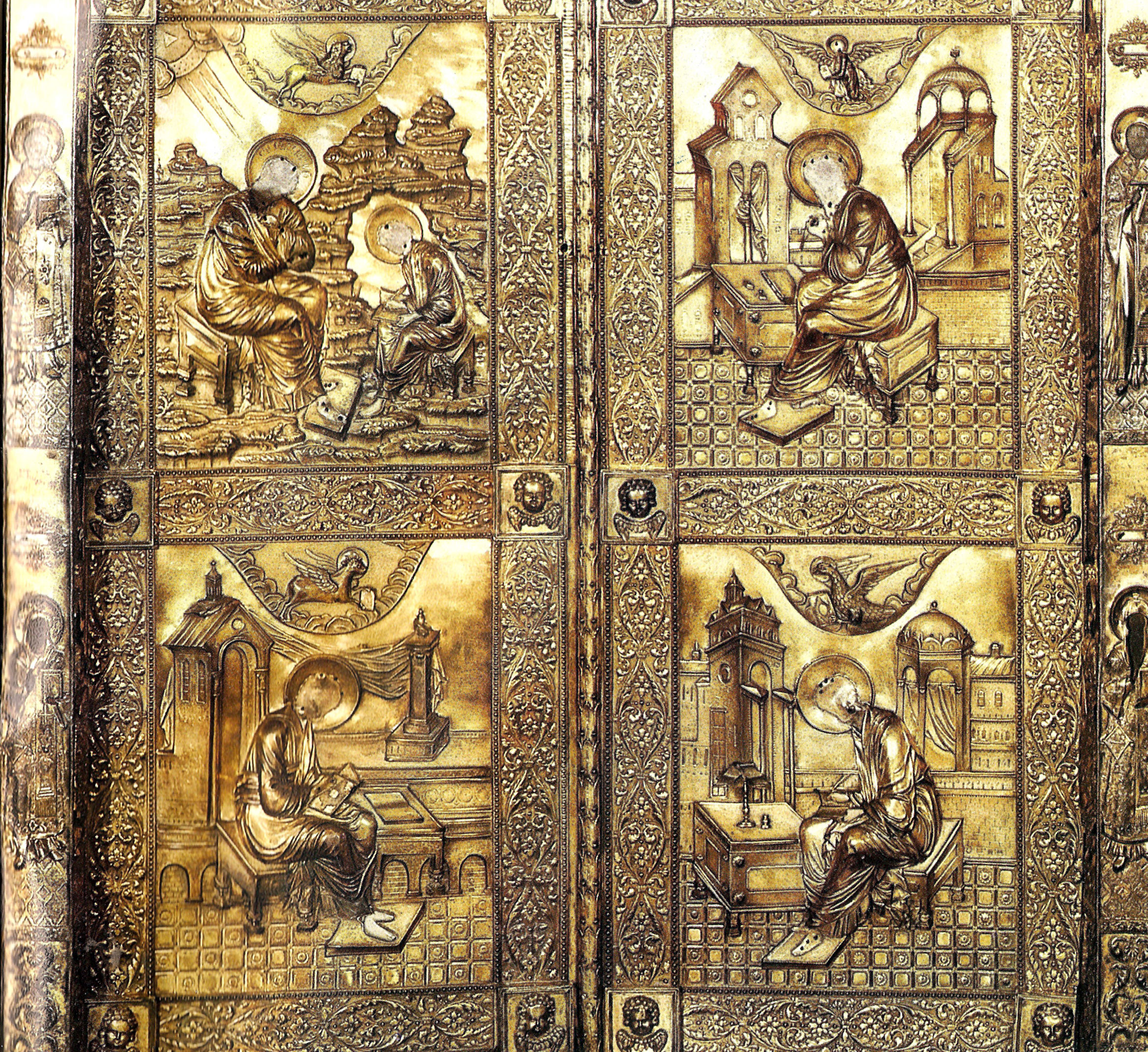
Царские врата. XIX в. Деталь. The Holy Doors. 19th century. Detail
The representative character of the figures is emphasized by the use of paints of pure-vermilion, emerald-green, blue, white and light-blue colours applied over large surfaces. Painted in the chancel, on the topmost parts of the Cathedral's walls and on the choir loft are figures of the patron saints of Novgorod, Tver, Pskov, Rostov, Chernigov, and the other lands incorporated in the united Russian State.
A true gem of the Cathedral of the Annunciation is its many-tiered iconostasis. It comprises icons that were painted at different times. The icons of the deesis and festal tiers are the oldest. These are outstanding specimens of the Moscow school of icon painting created in the period of blossoming of Russian culture in the late 14th and early 15th centuries, which followed the victory in the Battle of Kulikovo (1380). The icons were renovated over the centuries past. As a result of scientific restoration carried out after the Great October Socialist Revolution of 1917, the ancient paintings saw the light once again. Undoubtedly, their authors were great masters.
There are two hypotheses about the origin of the iconostasis of the Cathedral of the Annunciation. The one, a more traditional hypothesis, maintains that the icons of the festal and deesis tiers are associated with the names of the famous painters Theophanes the Greek, Andrei Rublev, and Prokhor of Gorodets. According to this version, the iconostasis suffered minor damage in the fire of 1547 and has survived to this day. Besides, the chronicles of 1405 mention the names of these artists in connection with the decoration of the Cathedral with frescoes. By tradition, these same masters were to paint the icons for the iconostasis. The three distinct styles which are to be seen in the paintings of the deesis and festal tiers seem to corroborate this assumption. According to the other hypothesis, which was put forward in the 1960s, the interior of the Cathedral of the Annunciation was completely destroyed by the fire in 1547. After the restoration of the interior, a number of old icons were brought to the cathedral from various cities and several new ones were painted for it on an order of the Tsar. These icons might well include works by Theophanes the Greek and Andrei Rublev.
The two-metre-high icons of the deesis tier are traditionally believed to be executed by Theophanes the Greek. The tall graceful figures in tranquil solemn poses are interceding with Christ, whose image is the central one in this tier, for mankind. The icons are at a considerable distance from the floor, yet they are easily discernible thanks to the laconic and clear outline of the figures painted on a light background, which once used to be golden. Each personage is extremely expressive and marked by vivid individuality and great spiritual power.
The cycle of icons of the next, festal tier, dedicated to the principal Christian feasts, was painted in the early 15th century. Researchers single out two groups in it. What the seven icons on the left side, except the 16th-century icon of The Mid-Pentacost, the fourth one from the wall, have in common is the specific features of treatment of the subjects from the Gospel, the rhythmic harmony of their parts and the smoothness of lines. The bright harmonious colours of each composition form a colour chord as it were. Such are The Annunciation, The Nativity, The Transfiguration, and Lazarus Raised to Life Again. By tradition, Andrei Rublev is believed to be their author. The seven icons on the right side are painted in a different style, characterised by somewhat straightforward symbolism and the use of rich contrasting colours. Such are, for example, Jesus Laid in the Sepulchre and The Descent into Hell. This group of icons is attributed to Prokhor of Gorodets.
The two upper tiers of the iconostasis comprise images of prophets and patriarchs, painted in the 16th century. Here it was for the first time in the history of Russian icon painting that full-length figures of prophets appeared on icons. It was also for the first time that the image of the Mother of God sitting on the throne with infant Christ in Her arms was placed in the centre of this tier. The delicate noble faces, the small and slim hands and feet, the dynamic postures emphasised by fanciful shapes of the scrolls, and the richly ornamented attire of various styles are features characteristic of the Russian icon painting of the mid-16th century. Researchers believe that these icons were painted by artists of the Moscow school of icon painting.
The images of patriarchs, placed in the topmost tier at a considerable height are difficult to make out clearly from below. Yet characteristic of the figures painted against the background of tentlike structures is the same exquisiteness of colour combinations which is to be seen in the icons of the prophets' tier. This part of the iconostasis took shape rather late, by the 1770s; at the time, the images of patriarchs were installed in large boards with the tops made in the form of kokoshnik.
Of particular interest among the many icons with which the Cathedral of the Annunciation was adorned in olden times is the Four-Part icon put on the southern wall. This icon, painted by Pskov masters, was placed in the bottom (local) tier of the iconostasis in the early 1550s. This type of icon, showing four subjects on a single board, was not new in Russia at the time. However, this particular Four-Part icon was distinguished by a new symbolism, which brought about heated arguments. It is known, for example, that Metropolitan Makary had to give explanations in this connection and to defend its conception at the Church Council of 1554. The icons of Our Lady of Tikhvin with scenes from Her life and of The Redeemer of Smolensk with parables from the Gospel shown on the margins, created in Moscow in the mid-16th century, are more traditional in form. In the marginal pictures new trends in icon painting connecting, it with book miniature painting, such as an enhancement of the narrative principle, increased attention to landscape and architecture, and thoroughness in painting all the minute details vividly manifested themselves. The new features are to be seen especially clearly in the icon of The Redeemer of Smolensk, where each marginal picture is accompanied by a text (fragments of the texts have survived on the background). The icon of St Nicholas with the Book of Life attracts attention. According to an inscription in one of the lower marginal pictures, it was created by master Fedot Ukhtomsky in 1699. Signed icons are a rarity in old Russian art.
The gilded silver Holy Doors of the iconostasis was made in the first third of the 19th century to replace the old one which disappeared during the retreat of Napoleon's Grande Armee from Moscow. It is adorned with images of the four Evangelists and a scene of the Annunciation skilfully executed using the repousse technique.
The great frame into which all the icons of the iconostasis are installed was made from gilded chased bronze with coloured enamel inserts in the 19th century.
The Cathedral is lighted with big silver-plated copper chandeliers made at different times: in the 17th, 18th and 19th centuries.
One traveller, who visited the Cathedral of the Annunciation in the 17th century, made special mention of the Cathedral's floor paved with "slabs of marble of most beautiful colours". The floor is inlaid with tiles of agatelike jasper, which are believed to have been brought here from Rostov-the-Great in the mid-16th century. It plays a substantial part in the interior decoration of the Cathedral, and its warm red-brown hues harmonize perfectly with the general tonality of the murals and icons.
The original portals leading from the gallery into the Cathedral J lave not survived. The portals in the northern and western galleries in the form of broad arched frames decorated with spiral scrolls in the shape of volutes on their sides were made in the early 16th century. The arches are supported by pairs of columns with Corinthian capitals. The portals are decorated with an exquisite carved floral ornament covered with light-blue paint and gilt. It was executed by Italian master stone-carvers who were working in the Kremlin at the time.
The tall doors of the Cathedral, made of forged iron, are covered with sheets of red copper on the front side. In the 16th century, on them, subjects from the Bible, sibyls and prophets, as well as explanatory inscriptions were painted in gold. This technique, which was well-known in Byzantium and in the West, was also widespread in Russia. Today such doors are a rarity. In the Moscow Kremlin, they adorn the Cathedral of the Annunciation and the Cathedral of the Dormition.
In the 15th-16th centuries, the north-western part of the gallery served as the main entrance to the Grand Duke's palace on the side facing the Cathedral Square. Its highly raised vaults and wide open arches, which were glazed later on, imparted an especially grand appearance to its architecture. The artistic makeup of the gallery took shape in the mid-16th century, when its vaults and walls were decorated with murals. In the subsequent centuries, it underwent certain alterations. Thus, the white-stone capitals of the pilasters were replaced with their replicas cast in plaster of Paris in the 19th century. Only one original capital, which is to be seen at the end of the western gallery, has survived.
The first mention of the gallery's murals made in the chronicles dates back to 1520. Presumably the murals were done over after the fire of 1547. In the subsequent centuries, the frescoes were renovated more than once. As a rule, in the places where the original painting had been destroyed together with plaster, masters repeated the old pictures on new plaster, and thus the essential pattern of the gallery's frescoes has on the whole been preserved from the 16th century. However, the old murals were completely hidden under several layers of later over-paintings.
The first scientific restoration of the gallery's paintings was carried out in the early 1980s. It was aimed at uncovering the ancient layer of painting. It was decided to leave the old paintings as they are today. Where the original layer had been lost, the restorers left 19th-century paintings, having removed soil from their surface.
The entire vault of the gallery is taken up by a multi-figure composition The Tree of Jesse - the genealogy of Christ, based on stories from the Bible. Its individual figures and subjects are united by the motif of stylised light-green grapevine painted on a golden background. The composition begins at the entrance to the northern gallery. The main representatives of the lineage - Jesse, David and Solomon - are shown in oval wreaths along the centre of the vault. In the tendrils of the offshoots branching off from the stem, figures of prophets, prophetesses and fathers of the Church and scenes from the Gospel story of Christ are painted. The genealogical tree is crowned by the immage of the Mother of God on the throne with infant Christ in Her lap, painted on the vault facing the western entrance to the Cathedral.
Among the figures painted on the wall spaces between the windows and on the foot of the vault are the classic philosophers and poets Homer, Virgil, Aristotle, and Plato. They are included in the composition on the genealogy of Christ as foretellers of the teaching about the Godman. The figures of the Ancient Greek and Ancient Roman sages with unfurled scrolls in their hands are clad in fanciful attire which is sometimes reminiscent of the traditional Russian costume. The portrayal of classic philosophers in the gallery of the Cathedral of the Annunciation was a new theme in 16th-century Russian painting.
The compositions Three Youths in the Fiery Furnace and The Ascension, a scene with prophets over the western portal and individual figures on the vault have survived practically intact. Thus today we can see the original structure of the compositions and admire the graceful brush and the light cold colouring combining deep-red, light-blue and green hues characteristic of the original decor of the gallery.
Three large compositions - The Trinity, In Thee Rejoiceth and The Miracle of the Prophet Jonah - are painted on the walls of the gallery. Of these, The Trinity is the least renovated composition, since it was covered with a valuable setting from the 18th century. It is painted in a full brush and perfectly inscribed in the space on the wall allotted to it. The somewhat corpulent figures of the angels have a majestic and solemn look.
The other two compositions illustrate the hymn in honour of the Mother of God and the Book of the Prophet Jonah. At the end of the 19th century, an attempt to restore them was made, which was a failure: the painted layer was almost entirely removed in search of an older painting, and the compositions had to be repainted on the old grafya.
At the end of the western gallery is a composition, The Feats of Monastery Recluses, and next to it is The Annunciation painted in oil in the place of an opening, which had been bricked up, in the 19th century. Over the entrance to the northern gallery, The Saviour Not Made with Hands (the Veronica), created by the celebrated master Simon Ushakov, "salaried painter" of the Kremlin's Armoury, in the second half of the 17th century, is to be seen. The composition takes up the entire end wall of the gallery. The face of Christ is painted in a realistic manner typical of Simon Ushakov, who was a theoretician and practician of a new trend in the painting of the second half of the 17th century. The artist created an image in which Christ's human principle predominates over His divine essence. This is the only work of monumental art by the hand of Simon Ushakov, known to exist today.
Originally, the southern gallery of the Cathedral was not connected with its north-western wing. The small arched opening connecting the two parts of the gallery appeared as late as the 19th century. The porch of the southern gallery was named the Groznenskoye Porch after Ivan the Terrible (Grozny); however, in his reign only the decorative setting of the entrance was made. A fragment of the ornamentation of the porch - a small carved brightly painted white-stone column dating from the 1570s - has survived. In the 1950s, the pointed portal in the gallery was reconstructed from late 15th-century fragments. Today the gallery is used for displays of icons and works of decorative and applied art.
The Cathedral of the Annunciation is an outstanding monument of Russian culture embodying the talent and effort of many generations of Russian architects, icon painters and jewellers.
|
ПОИСК:
|
© MUSEUMS.ARTYX.RU, 2001-2021
При использовании материалов сайта активная ссылка обязательна:
http://museums.artyx.ru/ 'Музеи мира'
При использовании материалов сайта активная ссылка обязательна:
http://museums.artyx.ru/ 'Музеи мира'